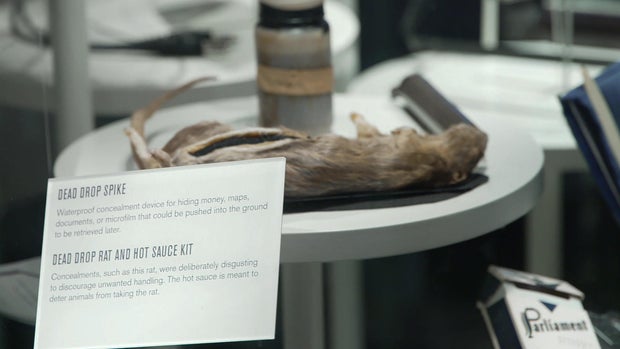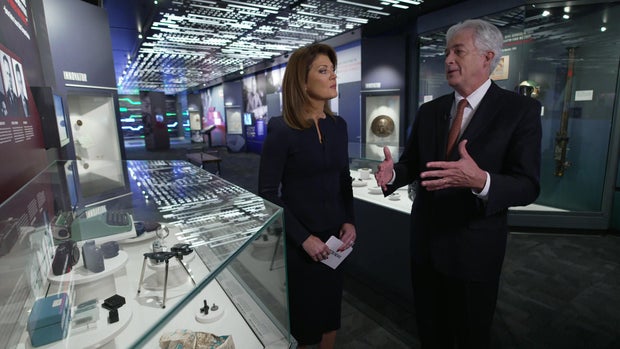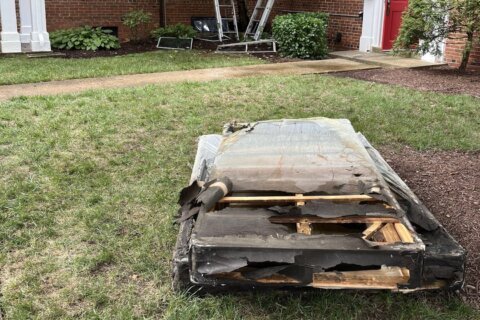▶ Watch Video: Inside the CIA’s museum of spycraft
The Hope Diamond, the Spirit of St. Louis, and the U.S. Constitution are just some of America’s national treasures on display in Washington, D.C. Now add to that list a brick from Osama bin Laden’s final hideout, and the AK-47 found by his side; flight suits worn by clandestine surveillance pilots; and a taxidermied rat, used by spies to hide messages during the Cold War.
These artifacts are among the hundreds on view at Central Intelligence Agency headquarters in suburban Virginia – on view, that is, only to those cleared to enter the high-security complex, such as CIA director William Burns, who offered a tour of “CBS Evening News” anchor Norah O’Donnell.
 Miniature cameras on display at the CIA Museum, at the Central Intelligence Agency’s headquarters in Langley, Virginia.
Miniature cameras on display at the CIA Museum, at the Central Intelligence Agency’s headquarters in Langley, Virginia.
CBS News
She asked, “Do we still use spy cameras?”
“We still use a lot of, you know, gadgetry like this,” he replied, “but it’s a lot more sophisticated now.”
“Kind of how, like James Bond?”
“Yeah, that’s James Bond plus, I think, these days as well,” he laughed.
 A taxidermied rat, used as a dead drop to conceal secrets, was effective at keeping away suspicious eyes; hot sauce applied to the rat would keep away scavenging animals.
A taxidermied rat, used as a dead drop to conceal secrets, was effective at keeping away suspicious eyes; hot sauce applied to the rat would keep away scavenging animals.
CBS News
The CIA’s museum highlights the high-tech side of spycraft, but its true purpose is to inspire employees with stories like that of agent Marti Peterson. In the 1970s, Peterson was assigned to work with a recruited Soviet informant code-named Trigon.
 CIA agent Marti Peterson.
CIA agent Marti Peterson.
CBS News
Burns said, “Marti happened to be the first female CIA case officer to serve in Moscow, and this was to take advantage of what was a blind spot for the KGB at the time, ’cause the KGB in those years tended to be very dismissive of the capacity of women to conduct intelligence operations.”
“They didn’t think a woman would be a CIA spy?” asked O’Donnell.
“They did not. So basically what Trigon would do was use cameras like these to photograph documents, he’d put the film either in a hollowed out rock or a hollowed out brick or old milk cartons, and leave it in mutually-arranged dead drops and locations around Moscow that Marti would then come and collect.”
Eventually, the KGB arrested Trigon, and he swallowed a suicide pill rather than be interrogated. Shortly after, Peterson was captured and expelled from the Soviet Union. It’s a lesson in the risks taken by CIA agents – and those who come to trust them.
O’Donnell asked, “How important is the intelligence you get from human sources?”
“Collecting intelligence from human sources is a very important part of CIA’s mission,” said Burns. “Our officers are working literally as we’re sitting here to try to recruit foreign agents and to try to work with them to obtain intelligence that can directly help ensure the safety and security of American lives.
“I have a profound obligation as director of CIA, to protect them,” he said. “On the right side as I walk in every morning there’s our memorial wall, which has 139 stars on that simple marble, each one honoring a CIA officer killed in the line of duty. So, there’s not a moment when I walk by that wall when I’m not reminded of my obligation to take care of people. And that means protecting sources and methods.”
 The CIA’s memorial wall.
The CIA’s memorial wall.
CBS News
The past few months have been dominated by reports about the potential mishandling of human-source intelligence by former President Donald Trump.
- Mar-a-Lago search warrant released, reveals FBI seized top-secret classified documents
- How Trump handled classified documents
- Trump kept more than 700 pages of classified records at Mar-a-Lago (“CBS Evening News”)
- Trump claims presidents can declassify documents “even by thinking about it”
Burns could not speak about what was found at Mar-a-Lago, but he made clear what’s at stake.
O’Donnell asked, “How damaging is it to the agency if human sources are revealed, or if this human intelligence is compromised?”
“Well, you know, without commenting on any particular investigation, I mean, I think there are lots of instances in the past when compromising, you know, that human intelligence, failing to protect it carefully, being reckless about it, has cost lives,” he replied.
 CBS News’ Norah O’Donnell with CIA director William Burns.
CBS News’ Norah O’Donnell with CIA director William Burns.
CBS News
The CIA Museum does nod to such failures – assets killed through the treachery of turncoat spy Aldrich Ames in the 1980s; it also covers the 1961 Bay of Pigs fiasco, as well as the 2003 agency assessment that finding weapons of mass destruction in Iraq would be “a slam dunk.”
Still, it’s hard not to marvel at operations like Project Azorian, the 1970s salvage of a wrecked Soviet submarine. The CIA enlisted billionaire Howard Hughes to provide a cover story: that his ship, the Glomar Explorer, was searching for minerals on the ocean floor, rather than helping the CIA harvest Soviet military secrets.
“The press did find out about it, right?” asked O’Donnell.
“They did. In 1975, a year after the successful salvaging of a large section of the Soviet submarine, the Los Angeles Time broke the story. And the Ford administration, for the first time, used what became known as the ‘Glomar response,’ which was, ‘We can neither confirm nor deny this story,’ which you’ve heard a few times since then.”
“I know! And now, I finally put it together, because there’s many times as reporters we’ve asked for information and we get the ‘We can neither confirm nor deny.’ And this is it? This is where it came from?”
“That’s where it all started, yeah,” said Burns.
For the CIA director, one new exhibit has particular meaning. It features a model of the house in Kabul, Afghanistan where the last surviving mastermind of the 9/11 attacks, Ayman al-Zawahiri, was hiding. This past July, Burns took the model to President Biden to obtain the go-ahead for the drone strike that would kill the terrorist leader.
 A model of the house of Ayman al-Zawahiri, which became the target of a drone strike, killing the last surviving 9/11 plotter.
A model of the house of Ayman al-Zawahiri, which became the target of a drone strike, killing the last surviving 9/11 plotter.
CBS News
“A few days after the strike against Zawahiri, I was in New York City and, you know, made a quiet visit to the Ground Zero Memorial,” said Burns. “It gives you an opportunity to reflect a little bit, in this case, on the measure of justice that the Zawahiri strike, as well as the bin Laden strike 10 years before, had brought for the 9/11 victims and their families – but also for CIA officers who had lost their lives.”
He showed O’Donnell seven stars on display: “These are seven CIA officers who lost their lives on the hunt for Zawahiri 13 years ago in 2009. So, for CIA, that’s not something that any of us have ever forgotten.”
To preserve the memories of the missions and the people who carry them out is the aim of this most unusual museum, dedicated to the secrets kept behind the intelligence agency’s walls.
For more info:
- CIA Museum, Langley, Va.
- “America’s Hidden Stories: CIA Museum Declassified” on the Smithsonian Channel
- International Spy Museum, Washington, D.C.
Story produced by Ed Forgotson and Olivia Rinaldi. Editor: Remington Korper.







